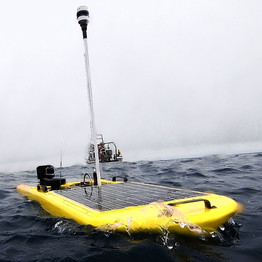Liquid Robotics Inc has received the 2010 Technology Innovation Award from Wall Street Journal for developing Wave Glider an unmanned robotic seafaring craft propelled by solar and tidal power.
The Wave Glider comprises a surface glider and an underwater glider with wing-like solar panels capable of providing 43 W of solar power. The up-and-down movements of waves are converted into a forward thrust. The solar panels help in the indefinite propulsion of the vehicle, thereby eliminating the requirement of alternative power sources or batteries. The communication, control and steering system of this unmanned craft requires a sustained power supply of 0.7 W.
 Wave Glider Robot
Wave Glider Robot
Information from the Wave Glider is communicated to the shore through a satellite and can be remotely controlled by means of a computer interface with internet connectivity. The payloads included in this unmanned sea craft include common meteorological and oceanographic (METOC) sensors and passive acoustics for marine mammal monitoring.
The company has reported that the Wave Glider offers competent and extensive research, inspection and exploration and it can profoundly support all levels of offshore renewable energy projects.
So far, Wave Gliders have covered 100,000 miles of exploration operations and have sailed continuously for more than 2500 miles within a time span of 400 days. These unmanned vehicles have sustained even in extreme environmental conditions like swells exceeding 18 feet, peak wave heights of over 21 feet and winds above 50 knots. Recently this robot was utilized to inspect situations in the Gulf of Mexico during the BP oil spill catastrophe.